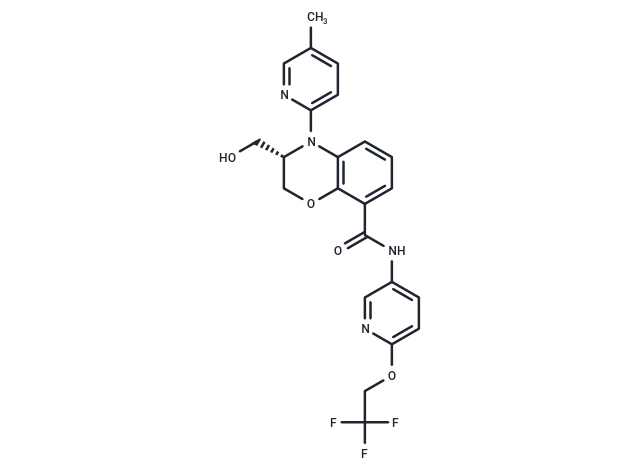Shopping Cart
Remove All Your shopping cart is currently empty
Your shopping cart is currently empty
JTS-653 is a potent and selective in vitro and in vivo antagonist of transient receptor potential vanilloid 1 (TRPV1). It effectively attenuates chronic pain resistant to non-steroidal anti-inflammatory drugs.

| Pack Size | Price | USA Warehouse | Global Warehouse | Quantity |
|---|---|---|---|---|
| 5 mg | $970 | Inquiry | Inquiry |
| Description | JTS-653 is a potent and selective in vitro and in vivo antagonist of transient receptor potential vanilloid 1 (TRPV1). It effectively attenuates chronic pain resistant to non-steroidal anti-inflammatory drugs. |
| In vitro | JTS-653 effectively inhibits the activation of human and rat TRPV1 channels induced by proton and capsaicin, with IC50 values ranging from 0.236 to 0.347 nM, demonstrating its potent blocking capability. Additionally, it exhibits strong inhibition of heat-induced inward currents in rat TRPV1 with an IC50 of 1.4 nM and displaces [3H]RTX binding to both human and rat TRPV1 in a dose-dependent manner, achieving Ki values of 11.44 and 4.40 nM, respectively[1]. |
| In vivo | JTS-653 effectively mitigates Capsaicin-induced mechanical hyperalgesia at a dose of 1 mg/kg orally and reduces Carrageenan-induced mechanical hyperalgesia at 0.3 mg/kg orally. It also significantly decreases Carrageenan-induced thermal hyperalgesia at 0.1 mg/kg orally and completely reverses it at 0.3 mg/kg orally, without impacting the swelling of the Carrageenan-treated paw. Furthermore, JTS-653 induces a temporary increase in body temperature at a dosage of 0.3 mg/kg orally. It alleviates chronic pain, which is unresponsive to non-steroidal anti-inflammatory drugs in both rats and mice, covering conditions such as post-herpetic pain. The effectiveness of JTS-653 is dose-dependent, showing statistical significance at doses of 0.3 mg/kg and above. In an animal model using male Sprague-Dawley rats aged 5 to 6 weeks, administering JTS-653 at dosages of 0.3, 1, and 3 mg/kg illustrated a partial alleviation of mechanical hyperalgesia in the L5 spinal nerve ligation model at 0.3 mg/kg. It increased the paw withdrawal threshold, indicating pain relief at 0.5, 2, and 8 hours post-administration, with the effect ceasing by 25 hours. The maximum beneficial impact was observed with a 1 mg/kg dose at 2 hours post-administration. |
| Molecular Weight | 474.44 |
| Formula | C23H21F3N4O4 |
| Cas No. | 942614-99-5 |
| Smiles | Cc1ccc(nc1)N1[C@@H](CO)COc2c1cccc2C(=O)Nc1ccc(OCC(F)(F)F)nc1 |
| Storage | Powder: -20°C for 3 years | In solvent: -80°C for 1 year | Shipping with blue ice/Shipping at ambient temperature. |
| Size | Quantity | Unit Price | Amount | Operation |
|---|

Copyright © 2015-2026 TargetMol Chemicals Inc. All Rights Reserved.